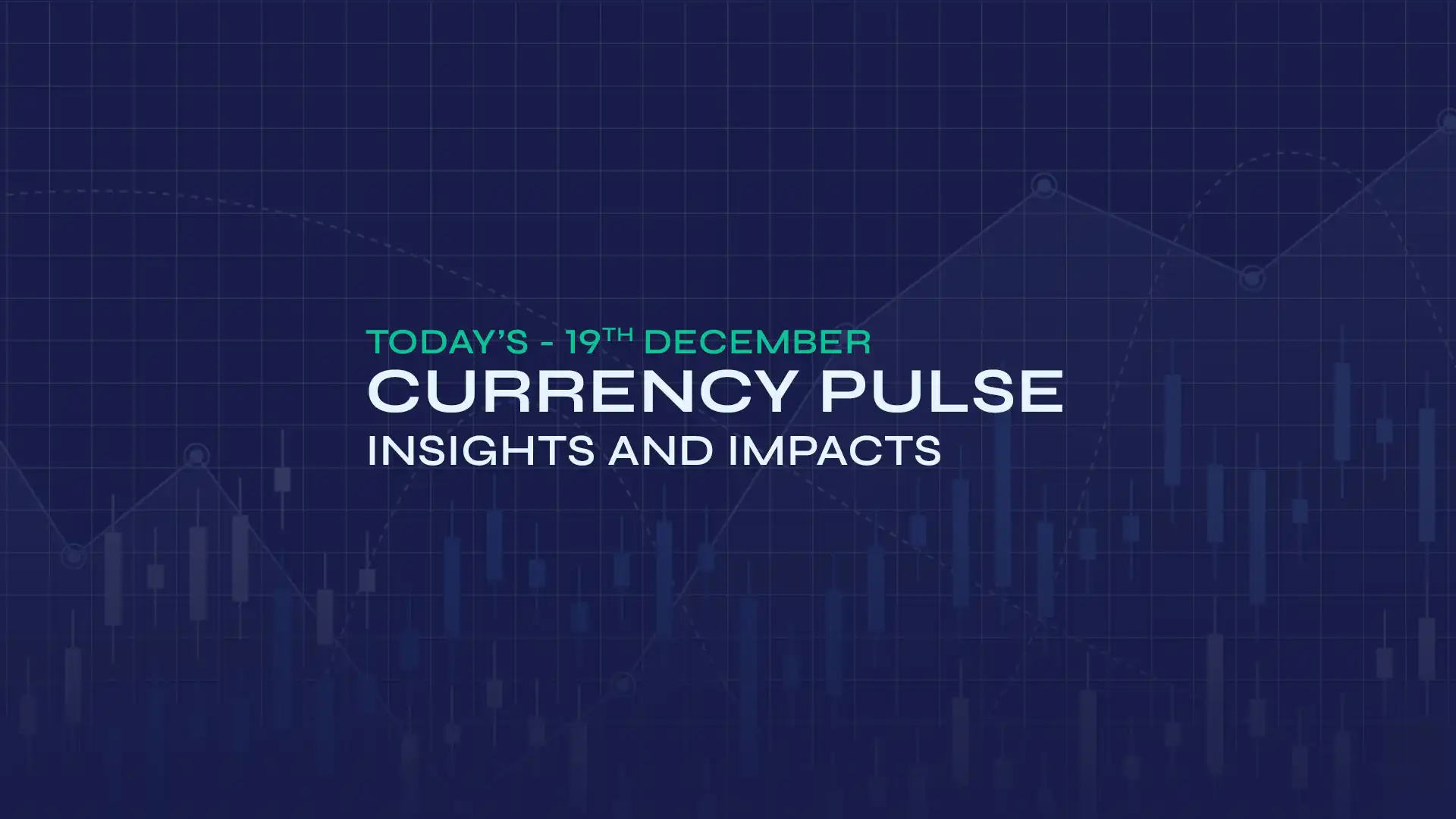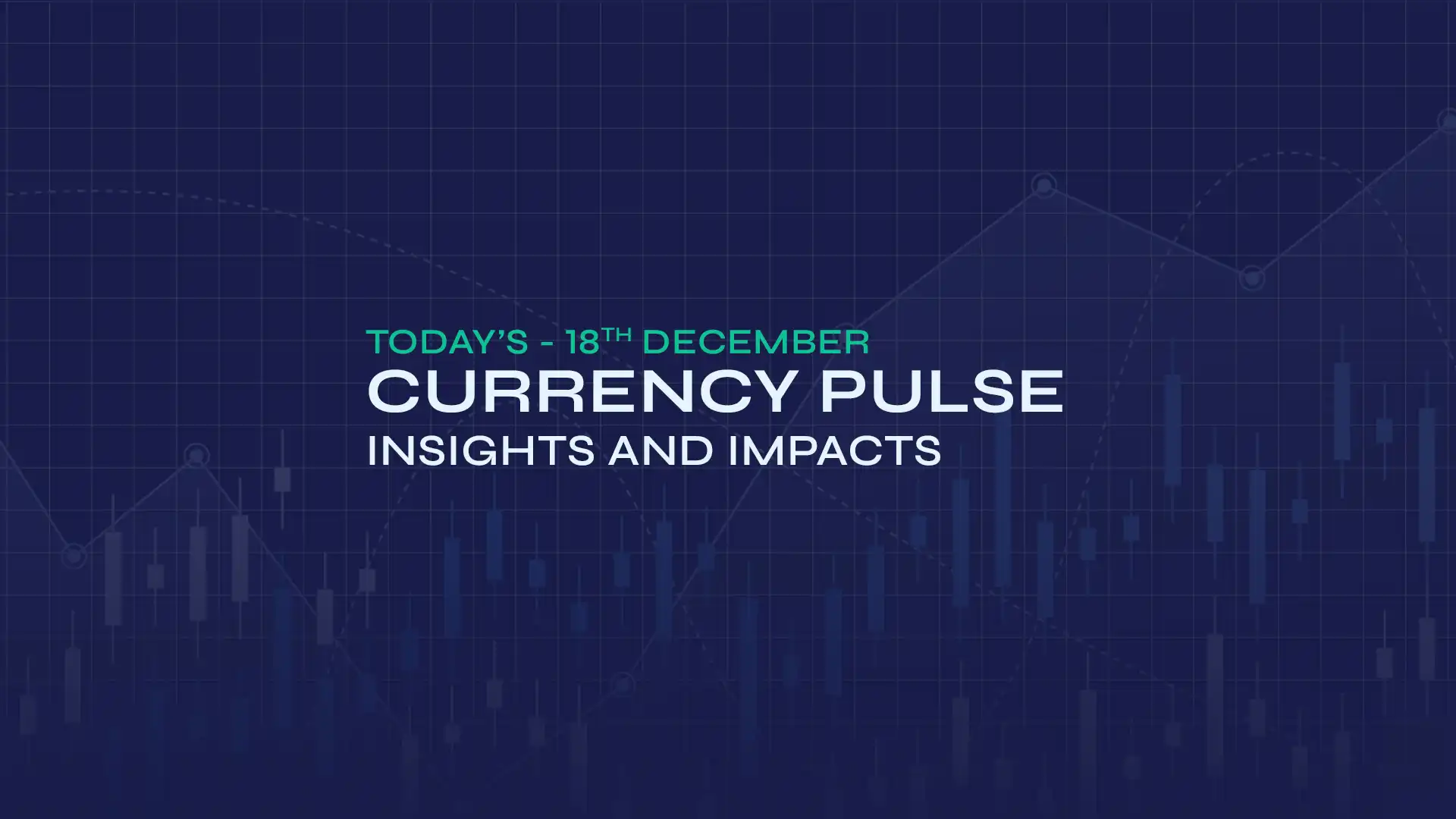GBP/USD recovered near 1.3567 as a string of disappointing US economic data, combined with rising trade uncertainty, weighed on the greenback. In May, the US service sector saw a slight contraction, with the Institute for Supply Management's (ISM) Services Purchasing Managers' Index (PMI) falling to 49.9 from April's 51.6. This figure was below the anticipated market value of 52. Additionally, the report indicated that the Prices Paid Index, reflecting inflation, increased to 68.7 from 65.1, while the Employment Index rose to 50.7 from 49. In May, private sector employment in the US grew by 37,000, and annual wages increased by 4.5% year-over-year, as reported by Automatic Data Processing (ADP) on Wednesday. This figure came after a revised gain of 60,000 (previously 62,000) in April and was significantly lower than the market expectation of 115,000. On Wednesday, President Trump repeated his criticism of the Fed following the release of the disappointing ADP employment data in a post on Truth Social for not lowering interest rates. "ADP NUMBER OUT!!! 'Too Late' Powell must now LOWER THE RATE. He is unbelievable!!! Europe has lowered NINE TIMES," Trump wrote.
On Wednesday, an increase in steel and aluminium import tariffs from 25% to 50% came into effect, renewing fears of a trade war between the world's two largest economies. US President Trump signalled in a post on Truth Social that it is challenging to make a deal with Chinese leader Xi Jinping. "I like President Xi of China, always have, and always will, but he is VERY TOUGH AND EXTREMELY HARD TO MAKE A DEAL WITH!!!" Trump wrote. However, market experts are somewhat optimistic about the US and China reaching a trade deal, as Trump's post indicated that he has commenced direct conversations with President Xi.
On the sterling front, market anticipation that the Bank of England's (BoE) monetary policy outlook, along with potential hopes surrounding the US-China trade discussions, has strengthened the pound. While the BoE is unlikely to lower interest rates again due to the escalating inflationary pressures and stable labour market conditions, BoE Governor Andrew Bailey's reaffirmation of a "gradual and careful" monetary expansion approach amid uncertainty over the global economic front could further fluctuate the sterling. Andrew Bailey stated before the Parliament's Treasury Committee on Tuesday, "I think the path remains downwards, but how far and how quickly is now shrouded in a lot more uncertainty." On the data front, the S&P Global Composite PMI rose to 50.3 in May, up from a preliminary 49.4 and April's 48.5, while the Services PMI climbed to 50.9, suggesting weak but marginal growth.
On the global front, rising uncertainty over trade negotiations between the US and China is expected to continue exerting pressure on the UK economy. Given that China maintains a low-cost competitive advantage worldwide, UK business owners could experience the strain of a price war in the international market if the world's two largest nations fail to reach a trade agreement. However, the UK has received temporary relief from the new 50% US tariffs on steel and aluminium that took effect on Wednesday. Under an executive order signed by President Trump, the UK will continue to face the previous 25% rate, thanks to a preliminary trade agreement reached last month. Nevertheless, London has five weeks to finalise the deal or risk the full tariff, leaving trade prospects uncertain.
In today's session, US-China trade discussions, weekly Initial Jobless Claims data, and speeches from influential FOMC members could provide some impetus to the GBP/USD exchange rate.
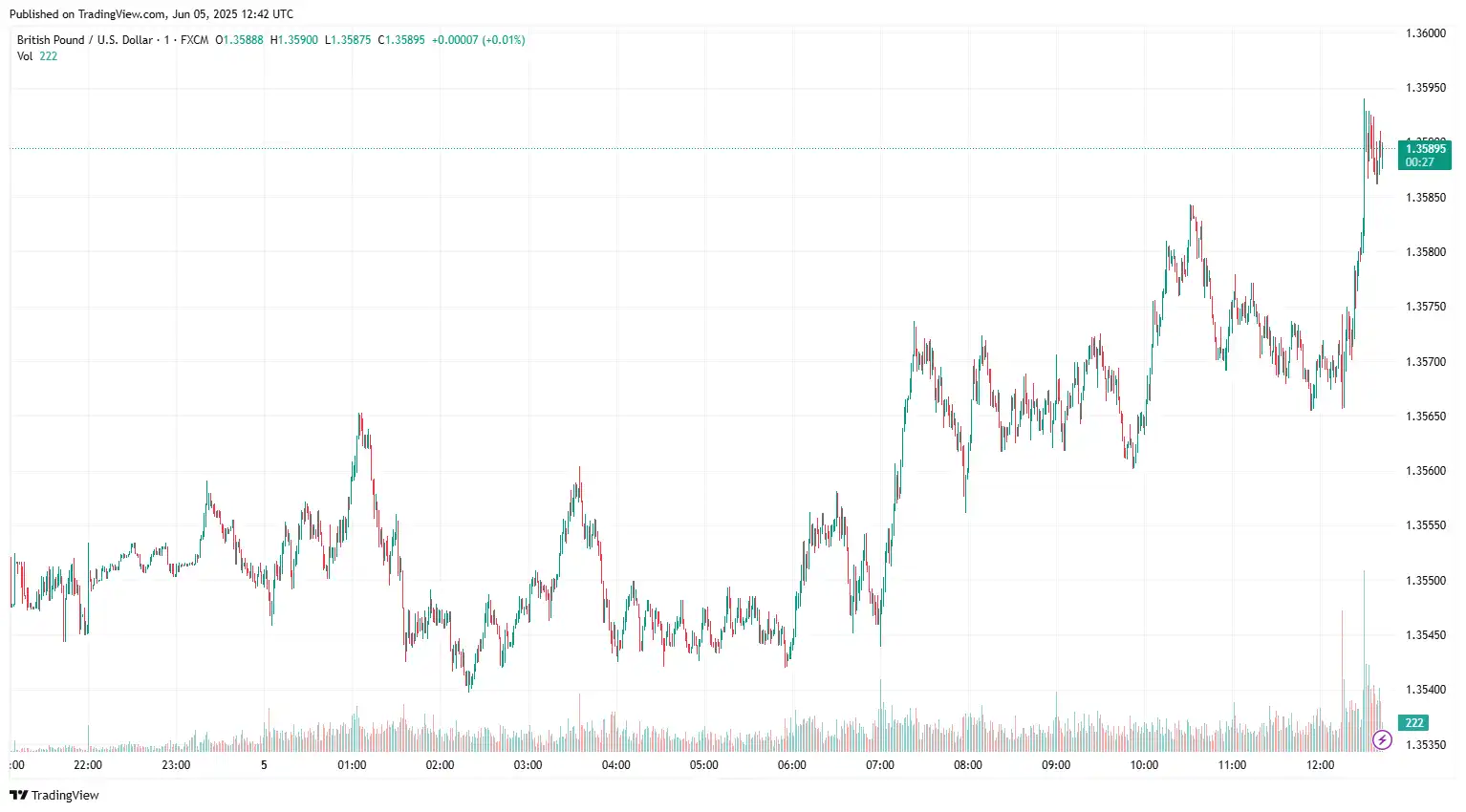
USD/CAD Subdued by BoC's Decision to Keep Rates Steady
USD/CAD weakened near 1.3665 following the Bank of Canada's (BoC) decision to keep its main reference rate steady at 2.75%, unchanged in Wednesday's policy meeting, matching broader market sentiment stemming from persistent inflationary pressures and ongoing uncertainty related to US trade policies. In the accompanying policy statement, the BoC highlighted that GDP growth for the first quarter surpassed expectations, driven by a surge in exports and inventory accumulation in anticipation of forthcoming US tariffs. Nevertheless, the central bank expects a notable deceleration in the second quarter, with subdued domestic demand and labour market weaknesses in trade-sensitive sectors. Recent economic data revealed that the S&P Global Canada Manufacturing PMI climbed to 46.1 in May from 45.3 in April, showcasing that the industry remains in contraction for a fourth consecutive month. Output and new orders continued to fall sharply. Labour productivity, released by Statistics Canada, fell below analyst estimates of a 0.4% increase in the first quarter, with the QoQ reading printing at 0.2% in Q1. Bank of Canada Governor Tiff Macklem provided insights into the central bank's policy outlook while responding to enquiries from reporters. He also expressed that the board will carefully observe the following two CPI reports as inflationary pressures remain volatile. He also noted that a renewed US trade deal would refuel economic activity; however, the uncertain outlook around US tariffs will remain a concern.
On the other hand, the greenback tumbled on an unexpected decline in the ADP employment change figure and the ISM Services PMI data, reinforcing the cautious market mood driven by the impact of US President Donald Trump's tariffs on the US economy and global trade. In May, the US service sector experienced a contraction in business activity, as indicated by the Institute for Supply Management's (ISM) Services Purchasing Managers' Index (PMI), which fell to 49.9 from 51.6 in April, declining below the market's anticipated 52.0. Additionally, the US ADP private sector employment saw an increase of 37,000 in May, compared to the revised figure of 62,000 for April, falling short of the market expectation of 115,000 by a substantial margin. On Wednesday, Federal Reserve Bank of Minneapolis President Neel Kashkari stated that there are indications the labour market is beginning to slow down. Nonetheless, the central bank should remain in wait-and-see mode to evaluate how the economy reacts to the prevailing uncertainty. He also emphasised that the Fed must stay in this cautious approach to gauge the economic response to the uncertainty.
In the upcoming sessions, the US Balance of Trade and the weekly Initial Jobless Claims, along with the Canadian employment report, trade balance, and PMI numbers, will shape market sentiment around the USD/CAD exchange rate.
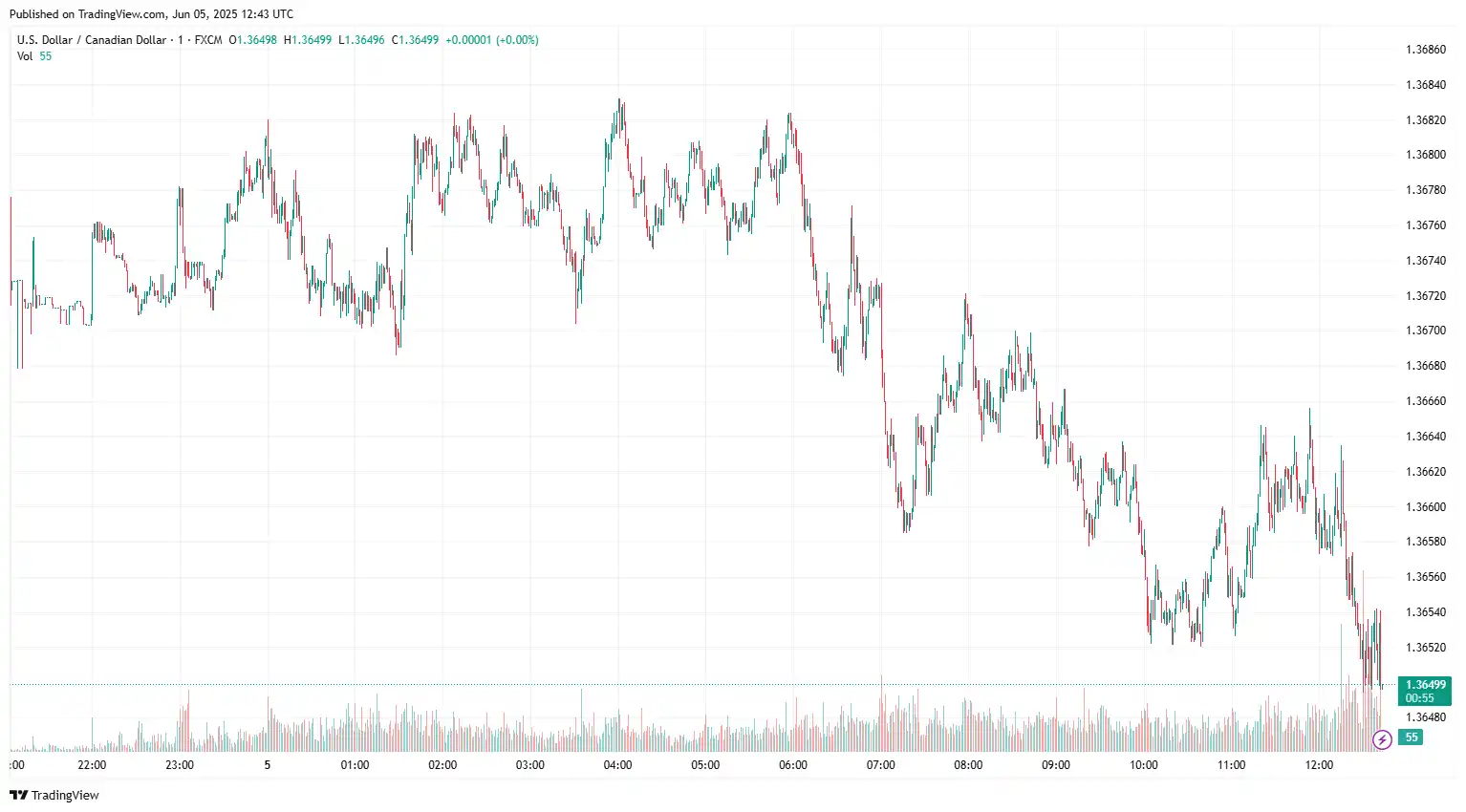
AUD/JPY Gains Amid Rising BoJ Rate Hike Bets
AUD/JPY edged higher to near 93.19 as the release of the domestic trade balance and China's Caixin Services Purchasing Managers' Index (PMI) data lent support to the Australian dollar. Australia's trade surplus fell to 5,413 million MoM in April, below the expected 6,100 million and down from a revised 6,892 million (initially reported as 6,900 million) in the prior month, according to the latest foreign trade data from the Australian Bureau of Statistics released on Thursday. Further examination reveals that Australia's exports declined by 2.4% MoM in April, down from the 7.2% (revised from 7.6%) seen a month earlier. In contrast, imports rose by 1.1% MoM in April, reversing a 2.4% drop (revised from -2.2%) in March. Additionally, Australia's Gross Domestic Product (GDP) increased by 0.2% QoQ in the first quarter (Q1) of 2025, a deceleration compared to the 0.6% growth in Q4 of 2024, as reported by the Australian Bureau of Statistics (ABS) on Wednesday. This growth rate was below the anticipated 0.4%. The annual GDP for Q1 rose by 1.3%, in line with the 1.3% growth in Q4, but it fell short of the consensus estimate of a 1.5% increase. Moreover, the Reserve Bank of Australia's (RBA) dovish stance could act as a tailwind for the Aussie.
On the geopolitical front, hopes for potential talks between US President Donald Trump and Chinese President Xi Jinping could further influence the China-proxy Australian dollar. Last week, Trump accused China of violating a recent tariff truce agreed upon in Geneva. The deal involved both countries temporarily reducing reciprocal tariffs. Trump claimed China had "totally violated its agreement with us," while US Trade Representative Jamieson Greer said China failed to remove non-tariff barriers as promised. In response, a spokesperson from China's Ministry of Commerce said China had complied by suspending or cancelling relevant tariff and non-tariff measures targeting US goods. China's Services Purchasing Managers' Index (PMI) edged up to 51.1 in May from 50.7 in April, matching the market consensus of 51.1 for the reported period. China's Caixin Manufacturing Purchasing Managers' Index (PMI) unexpectedly declined to 48.3 in May from 50.4 in April, falling short of market expectations for a 50.6 expansion.
On the yen's front, strengthening market sentiment that the Bank of Japan (BoJ) will continue interest rate hikes amid broadening inflation in Japan, driven by falling Japanese labour market numbers, dampens the Japanese yen. Thursday's labour data indicate nominal wages increased by 2.3% from a year earlier in April, marking the fastest pace in four months and up for the 40th consecutive month. However, real wages slumped by 1.8% as rising prices continued to outpace pay hikes. The consumer inflation rate, which is used to calculate real wages, eased slightly to a 4.1% YoY rate during the reported month, compared to 4.2% in March, though it remained above 4% for the fifth month in a row. The final au Jibun Bank Japan Services Purchasing Managers' Index (PMI) was revised from a 50.8 flash reading to 51.0, below the previous month's final print of 52.4. Meanwhile, BoJ Governor Kazuo Ueda sounded cautious on Tuesday, stating in Parliament that uncertainties over overseas trade policies and economic and price situations remain extremely high. Ueda added that there is no preset plan for rate hikes and that he won't push for higher interest rates unless the economy is strong enough to handle it.
Investors will closely monitor the trade-related uncertainties and US-China trade war fears for further insights on the AUD/JPY exchange rate.
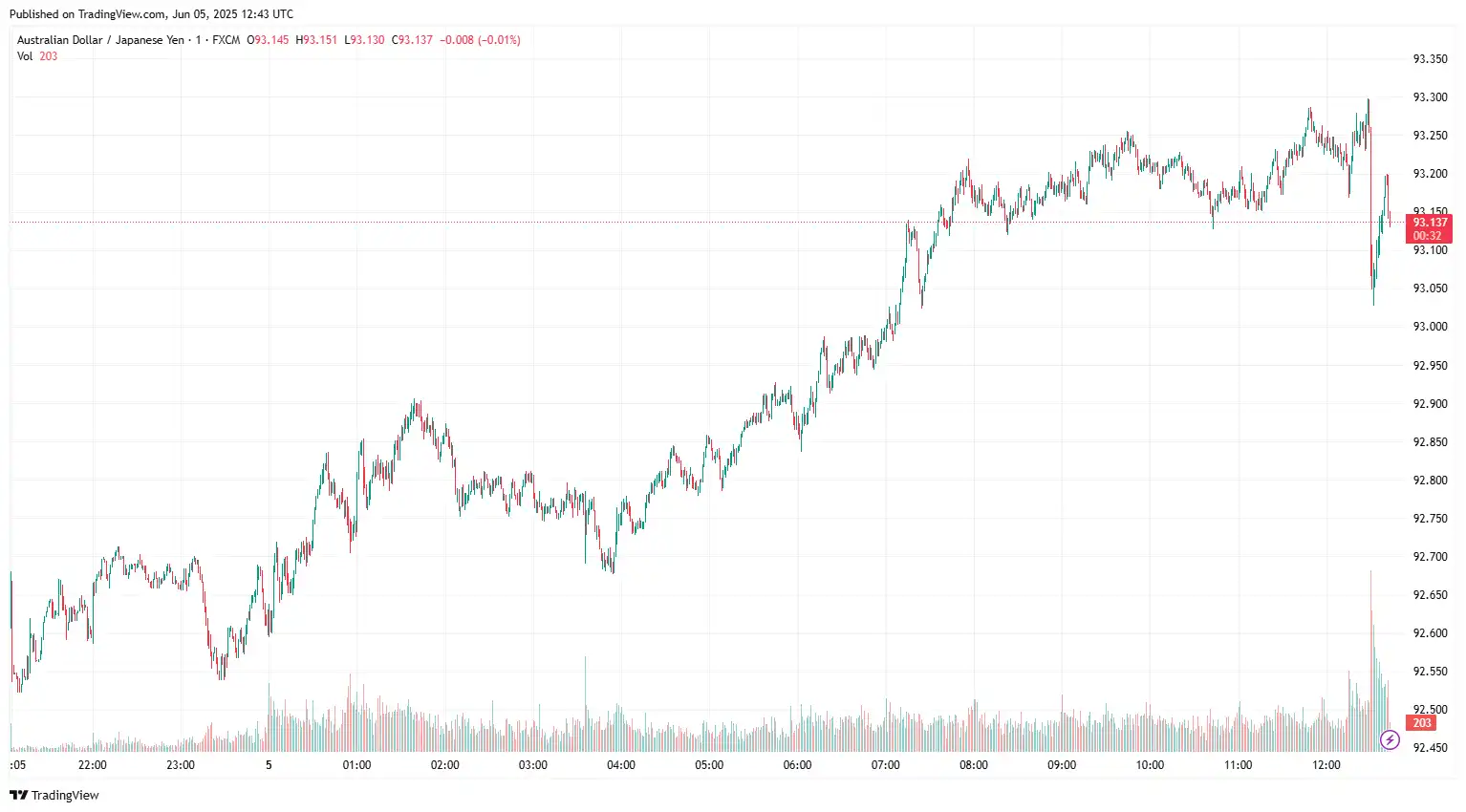
EUR/CAD Hovers as Bank of Canada Maintains Rate Steady at 2.75%
EUR/CAD struggled near 1.5600 following the Bank of Canada (BoC) announcement to keep interest rates unchanged at 2.75%, matching market anticipations. In its policy statement, the BoC pointed to unexpected strength in recent inflation data while noting that the Canadian economy is soft but not sharply declining. The Canadian economy is anticipated to be significantly weaker in Q2 compared to Q1, with a decline in exports and inventories. April's annual inflation rate, excluding taxes, was recorded at 2.3%, which is marginally stronger than anticipated. The board commented on the continuing trade conflicts, noting that the uncertainty surrounding US tariffs is significant. We will pursue further information regarding US trade policies and their effects. The board will monitor how US tariffs influence export demand, the speed at which cost increases are transferred to consumer prices, and the development of inflation expectations. Canadian labour productivity, as released by Statistics Canada, fell short of analyst estimates for a 0.4% increase in the first quarter, with the quarter-on-quarter reading recorded at 0.2% in Q1. Governor Tiff Macklem highlighted the ongoing trade conflict with the United States as the most significant obstacle for the Canadian economy, describing US policy moves as "highly unpredictable." While the central bank has chosen to remain on hold for the time being, Macklem cautioned that further rate cuts may be necessary if economic conditions worsen under the burden of escalating tariffs.
On the euro's front, investors await the European Central Bank's (ECB) interest rate decision. The market is highly anticipating that the ECB will reduce its key borrowing rates by 25 basis points, bringing the Deposit Facility Rate and Main Refinancing Operations Rate to 2% and 2.15%, respectively. HCOB Eurozone Composite PMI stood at 50.2 in May, slightly lower than the previous reading of 50.4 but above the forecasted 49.5. Meanwhile, Services PMI decreased to 49.7 from the previous 50.1, although it remains above the anticipated 48.9 figure. Furthermore, HCOB Germany Composite PMI fell to 48.5 in May, just below the projected 48.6 and April's reading of 50.1. Additionally, German Services PMI dropped to 47.1 from a prior 49.0. On Tuesday, the Eurozone Harmonised Index of Consumer Prices (HICP) rose at an annual rate of 1.9% in May, following a 2.2% increase in April, according to official data released by Eurostat. Markets had estimated a reading of 2% for the reported period. The core HICP advanced 2.3% year-on-year (YoY) in May, compared to a 2.7% growth in April, missing the 2.5% forecast. On a monthly basis, the bloc's HICP showed no growth in May, in contrast to April's 0.6% increase. The core HICP inflation stood at 0% month-on-month (MoM) during the same period, following an increase of 1% in April. Meanwhile, the bloc's unemployment rate fell to 6.2% in April, down from March's revised 6.3%. Germany's factory orders unexpectedly rose in April, suggesting that the country's manufacturing sector sustained its recovery, according to official data published by the Federal Statistics Office on Thursday. Over the month, contracts for goods 'Made in Germany' ticked up 0.6% in April after rebounding by a revised 3.4% in March. The data beat the estimates of -1%. Germany's industrial orders rose 4.8% year-on-year (YoY) in April, compared with the previously revised growth of 3.7%.
Broader market sentiment around the European Central Bank (ECB) interest rate decision and President Christine Lagarde's press conference will drive the EUR/CAD exchange rate.

Stay Ahead in the Currency Game
Whether you're a daily FX trader or handle international transactions regularly, our 'Currency Pulse' newsletter delivers the news you need to make more informed decisions. Receive concise updates and in-depth insights directly in your LinkedIn feed.
Subscribe to 'Currency Pulse' now and never miss a beat in the currency markets!
Ready to act on today’s insights? Get a free quote or give us a call on: +44 (0)20 7740 0000 to connect with a dedicated portfolio manager for tailored support.
Important Disclaimer: This blog is for informational purposes only and should not be considered financial advice. Currency Solutions does not take into account the investment objectives, financial situation, or specific needs of any individual readers. We do not endorse or recommend any specific financial strategies, products, or services mentioned in this content. All information is provided “as is” without any representations or warranties, express or implied, regarding its accuracy, completeness, or timeliness.



